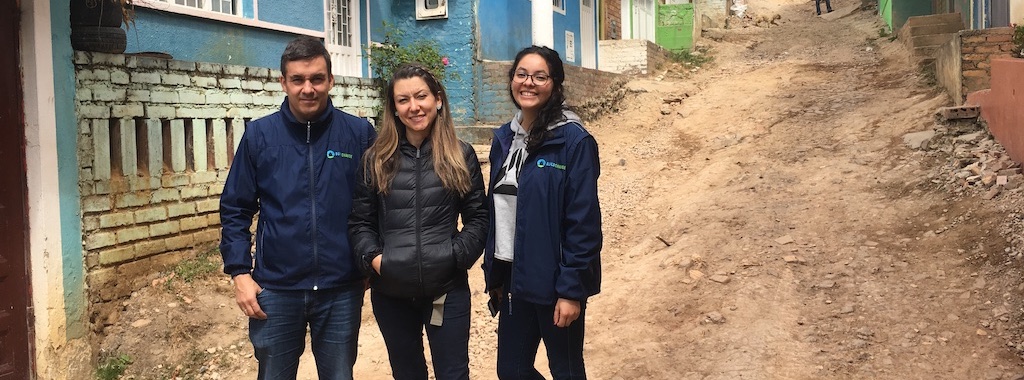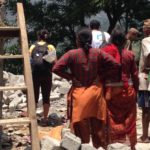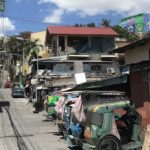The year is moving fast; my time supporting the team in Colombia is over. My time is now fully committed to the program in the Philippines.
During my initial trip, I had the chance to visit some of the communities where Build Change has been working and become familiar with the existing tools used in these communities. Also, I was introduced to the crucial role that microfinance institutions (MFIs) play in Build Change’s strategy to retrofit vulnerable houses in the Philippines.
A lot of questions came to mind after that trip. Specifically, how to transfer the governmental responsibility of having safer houses for the low-income population to an external agent, and how to make MFIs’ business of providing loans to retrofit houses profitable? Compared with Colombia, where the government plays the principal role of providing grants to homeowners to retrofit their houses, there is very little government involvement in improving informal housing in the Philippines. Instead, microfinance institutions play a pivotal role in working directly with homeowners to finance housing retrofits.
MFIs have been working in the Philippines for many years. According to the Banko Sentral ng Pilipinas and the Asian Development Bank, MFIs are organizations that offer a broad range of financial services such as loans, payment services, money transfers, and insurance products to low-income homeowners or households and their microenterprises. Small loans from microfinance institutions are recognized as an effective method of directly improving the lives of those in need — a service that can often have a long-lasting impact.
Homeowners and households must successfully navigate several steps to obtain credit from an MFI. For example, the homeowner has to submit a membership application, there is a background check investigation, there is general documentation to be filled out, and the homeowner must pay a safety deposit that is usually 20% of the total loan (applicable on some loans). This last requirement reduces, in general, the total amount of money that can be used in retrofit applications.
Deficiencies in informal construction in the Philippines are similar to deficiencies identified worldwide in these types of structures, including a lack of a ring beam on the top of masonry walls, inferior quality materials, inadequate locations of openings, excessive openings in shear walls, irregular layouts, and high gable walls. Developing a full retrofitting assessment and solutions for a house requires a lot of engineering effort and time in order to obtain buildable documents and building permits. As a result, Build Change developed a simplified approach focusing on eight deficiencies:
- All exterior walls must include a minimum solid wall length of 1.5 meters or 35% of the total length of the wall. This requirement reduces potential torsion effects in the house.
- Columns are required at the intersections and ends of walls, allowing the transformation of a partially confined or unconfined masonry system into a confined masonry system.
- Ring beams are required on top of the walls. Many homeowners of informal one-story houses wait to build a ring beam until the concrete slab is poured during a second floor expansion. In the meantime, these houses are vulnerable to earthquakes and wind forces.
- Openings must be protected by the placement of confining elements around them. This enhances the performance of the wall as a confined masonry member.
- For unplastered masonry walls, 1.5 centimeters of mortar plaster are specified at each side.
- If parallel walls spaced more than 3 meters apart exist, a new perpendicular CMU wall 1 meter long between parallel walls is required to buttress the walls for out-of-plane lateral forces.
- If a masonry gable wall exists, two options are specified: Construct a slanted ring beam at the top of the gable wall; or demolish the wall and replace it with a gable wall made of a lightweight material such as timber.
- Anchor the roof framing to the ring beams with metal straps, if not previously completed.
The full application of this retrofit strategy typically creates a total scope of work that far exceeds the loan amount accessible to homeowners through an MFI. Therefore, prioritizing and dividing the scope of work into different phases is required. It demands extra engineering time. To make this work scalable, existing resources must be improved to automate as much of this process as possible.
MFIs use loan officers as liaisons between the institution, the homeowner, and Build Change. Loan officers are usually salespersons without a technical background. However, the assessments that they perform require the loan officers to take actual house measurements. With very little guidance on how to take accurate measurements, they may find this process too complicated. Any confusion when performing an assessment will likely affect the quality of the final bill of quantities (BOQ) and scope of work.

In response to these problems, Build Change has created an XLMForm application using FieldSight, an application developed by UNOPS and the World Vision Nepal Innovation Lab to ensure Nepal is properly rebuilt after the devastating earthquake of 2015. This platform allows data collected by loan officers in the field to be directly monitored from Build Change’s office. A new feature of the app involves using pictures to help loan officers identify the elements that must be measured and minimize the judgment and interpretation required by the loan officer.
Currently, only a single typology (one-story houses without future expansions) is available in this simplified procedure. However, the goal is to extend the app to cover other typologies, such as one-story houses with the capacity for future expansion, two-story houses with a lightweight roof, one-story timber houses, and two-story houses built from multiple materials. With the development of more modules that can cater to more typologies of homes, we can cover a more significant portion of the market.

I had the chance to visit an MFI client in Southville, Rodriguez, Rizal. The requirements and scope of work determined previously for this client’s house by the MFI loan officer were very different from the type of intervention the homeowner was expecting. Many factors could have contributed to these differences. However, in my opinion, loan officers require more training and improved, user-friendly tools to ensure that a scope of work is generated that is consistent with the homeowner’s desires.
To conclude this blog, I believe that the approach and strategy adopted by Build Change to promote safer housing and better construction practices is correct, given the lack of government involvement in informal housing vulnerability. Homeowners committed to having a safer house play a key role in promoting better construction practices among local builders.
Improving construction practices is a long road, but it is the only way to ensure safer housing on a large scale, years and decades into the future. This aligns with Build Change’s mission to save lives and significantly reduce injuries and economic losses in earthquakes and windstorms. Additionally, becoming involved with the retrofitting of vulnerable houses can be a source of growth for MFIs, allowing them to reach more homeowners. That said, Build Change must continue to help MFIs with the technical support, the development of the tools, and the training of loan offices to achieve our final goal.






